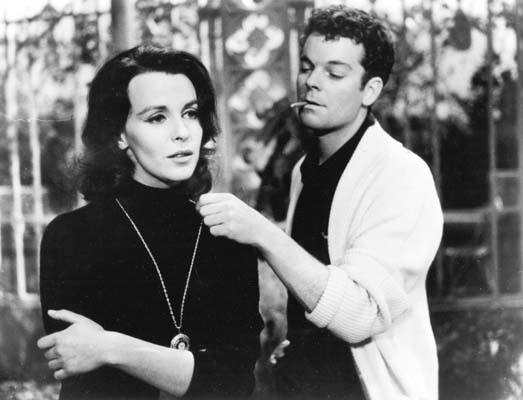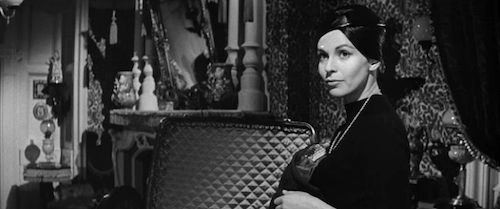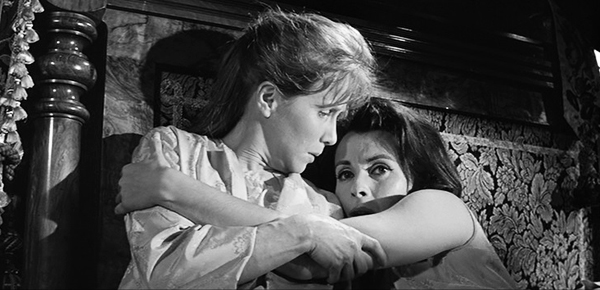If you’re anything like me then when the weather is beautiful you somehow end up ignoring the sunshine in favor of watching films in a dark room with the curtains drawn, a large nest of pillows and duvet and empty chocolate wrappers around you. Last weekend was one of those days when I finally managed to convince my girlfriend, A, to watch a horror film with me. The haggling process went like this:
A: No
Me: What if I give you pizza?
A: Okay, you have to buy me pizza.
Me: Done!
A: I mean, three pizzas. And you can’t have any.
Eventually I haggled her down to ONE pizza and 2 films that she could make me watch at a later date. She then foolishly decided to lower her price to be ‘One-Unspecified-Future-Favour.’ I think we all know who won that one.
So we settled down for a lazy Sunday afternoon of The Haunting. I figured it wasn’t going to be too bad for her because in between the scary suspense building bits the actors are being hilarious in the way that people in old movies (and small children) always are without realizing.

Theo doesn’t notice Luke because shes too busy having feelings about the spoken word poetry they’re watching
Basic Premise:
Based on a book written by Shirley Jackson, the plot centres around Dr. John Markway, an anthropologist obsessed with the idea of doing some research into a haunted house. He picks ‘Hill House’ and fills us in on a history of deaths and suicides that have occurred there before the events of the film. He manages to convince the current owner to let him and a team of ‘paranormal researchers’ run around the hallways for a few days and make notes. He is not the protagonist though, that honour is bestowed upon one of the women he invites to help him: the very nervous and highly strung Eleanor Lance. They are joined by slightly psychic Theodora (no last name) and very skeptical Luke Sanderson (the heir to the house). Spooky shit goes down, I can highly recommend it as a good gothic suspenseful horror and will attempt to not give you too many spoilers.
I understand there was a Catherine Zeta Jones remake but that they changed a lot about the plot from the original book and added a bunch of CGI, which quite frankly just isn’t needed. Kids today…
Anyway, not long into the film, A started to joke that Theo seems pretty gay. I laughed as we started to notice more and more things to add to our case (you’ve got to have a lot of background info on a character before you can take them to Lesbian Court).
Eleanor: What’s your apartment like?
Theo: Oh it’s an old place we’ve furnished ourselves from a lot of stuff we picked up from the junk shops. We both love fixing over old things.
Eleanor: Like me. (laughs) You married?
Theo: (pause) No.
After a while though we stopped thinking we were just reading this film with a gay lens (like I can’t help but do with Kiki’s Delivery Service) and actually looked it up online — where all the facts come from — and there it was. Theo is a lesbian.

The eyebrows. The turban. The dark hair. All classic signs of Lesbian.
Everyone will tell you that I have the worst gaydar (my Jewdar is only slightly better), so much so that I miss a lot of things that seem completely obvious to other people. I like to think it’s because I’m super enlightened and don’t factor assumptions about people’s sexuality into how I feel about them. I am above clichés and stereotypes and am a better person than all of you because of it.
But it’s probably more likely to be because we live in a hetronormative world and I assume everything is straight (white/rich/etc) until it tells me otherwise. Apparently liking Joan Armatrading is one of those things, and Fried Green Tomatoes, and the technical props manager at uni who used to have conversations with me about how Cyndi Lauper was much better than, and should have become more successful than, Madonna.
A is very smug that she noticed the gay before me.
When I first watched The Haunting, I was a small child so not really thinking too much about that kind of thing. I saw things that I thought just made her an Independent Woman — she’s smart, has some great lines (and great style — lots of black and even *gasp* trousers) — she beats Luke at cards, which his aunt has already said is an impossibility. She isn’t married, or anything like Eleanor (who is financially dependent on her sister and brother in law) and she seems far more confident and perceptive than the other characters — okay maybe the psychic abilities help. Basically Theo kicks ass and I just thought she was there to balance out Eleanor’s drippyness. In horror we’re so used to seeing women as victims or as evil, but Theo is neither.

Gaaaaaaaaaaaaaay.
Here’s what really hits me though. This is a portrayal of an out lesbian in a ’60s film from a book written in the ’50s — and it’s favourable. She’s not shown as predatory. She and Eleanor become good, supportive friends. And although a lot of horrors are written from a moralistic perspective (you do something bad = you get punished in a horrible scary way aka teenagers having premarital sex) — there is no moral judgement placed on Theo — she doesn’t die. The house doesn’t punish her for her sexuality.
There is a scene where Eleanor accuses Theo of being “unnatural” and it’s such a hard scene to decipher — is she talking about her psychic abilities? Or is she referring to Theo’s sexuality? They leave it deliberately ambiguous.
But really none of the characters ever treat Theo as lesser or Other. They don’t ask her invasive questions like which one of them wears the 1960s strap-on (did they have them then?) or make her explain herself. She is never presented as ‘wrong’ or ‘bad’, only occasionally bitchy, but in the best way.
So it made me wonder how many other queer characters are hidden in horror and how well they’re being treated by the genre. Are they all being hacked to death in the name of Christian values? Or are they all fighting ghosts to ’80s theme music? Are we even there at all? We were in the ’60s — who knew? Probably everyone but me.



I’ve loved the book and (’60s) movie versions of Theodora for a very long time. Claire Bloom is so lovely and, yes, terribly stylish in the movie, and the book is just as – if not perhaps more – clear about the character being a lesbian.
Interestingly, Shirley Jackson’s novel actually has Eleanor becoming emotionally attached to and fascinated with Theodora, rather than with the doctor (though it’s a complex relationship). There is a lot of (more subtle) queerness that I frequently perceive in Shirley Jackson’s writing, and I’m not sure if I’m reading into it excessively or not. A lot of intense connections between women certainly are present.
It is difficult to think of other queer women in older horror films who don’t receive the villain treatment or a moralistic punishment, as pointed out here. Theodora does stand out as an exception, and I bet it’s because – while apparent to us now that she’s a lesbian – it’s still subtle and coded enough to not clue in/rile up censors. Hmm… Yeah, who are the other queer characters of horror I’m blanking on/oblivious to…?
I should probably read the book – I’ve heard that it’s kind of more ambiguous in terms of how reliable a narrator Eleanor is? Which I find kind of interesting- the line between mental health and horror.
I’m actually making my way through every example of a queer character in horror films that I can find – to see how the genre treats them. I have an embarrassingly big spreadsheet with supposedly queer characters to check out!
The book is absolutely worth reading! Yeah, Eleanor definitely is a pretty unreliable narrator. Really, all of Jackson’s main characters are, and her writing is so fully located inside the minds of people who have a lot going on internally, who are very obsessive in their thinking, and who don’t think in especially ordinary ways. We Have Always Lived in the Castle very much highlights this (as does the last section of Hangsaman, which I finally just got to reading). I don’t know if you’ve read Sarah Waters’ The Little Stranger (her least queer novel, but my personal favorite), but it’s another horror novel that features a very unreliable narrator. (And on that Waters note, the characters Julia and Helen in The Night Watch have always reminded me a bit of Theodora and Eleanor.)
OMG that spreadsheet!!! That project sounds fascinating! I’d love to hear how it comes along. Really glad you wrote this article!
Can’t wait to see the results! Can we have a list of lesbian horror please – I’m currently having my own little Australian Gothic film season and need something for when that’s over. :)
Because I am quite queer myself, I too often wonder if I’ve been reading too deep into Shirley Jackson’s subtext both here and in other works. However, I think there is striking proof, in the language used to describe Eleanor and Theodora’s relationship, how they act, how Eleanor thinks, words spoken between them and also, their experiences together both with paranormal and mundane happenings. The scene where they go walking in the wood, both angry and hurt, is very intimate.
“Nothing irrevocable had yet been spoken, but there was only the barest margin of safety left them; both of them moving delicately along the outskirts of an open question, and, once spoken, such a question as– do you love me?– could never be answered or forgotten.”
This horrific scene in the wood is followed with Eleanor becoming interested in Theo (not that she wasn’t already before), almost in an obsessive way, and plans on leaving Hill House with her. Eleanor also often thinks of Theo as charming and attractive. And, it’s very, very clear that Theo is gay. Proof enough is found in beginning text where it’s described she’s living with a partner (whom is never given a gender (hint hint)) and they’re quite intimate. The description of their fight with one another reiterates this point.
Ugh I love posts like these so much. You’ve already done your research, so you might already know this, but Patricia White’s essay “Female Spectator, Lesbian Specter” (mostly on this film) should totally be of interest to you.
And yeah, I agree with the other comments – Shirley Jackson’s books are an absolute treat.
But hold up hold up… Is that Riff from West Side Story being all doctory?
I love her character in the 1960s version! I was afraid that she was going to die but she didn’t which amazed me me! I find her so intriguing. I loved how confident she was. I haven’t read the book, but I would love to. If I were in Eleanor’s position, I’d move with her in a heartbeat.
In the novel, towards the climax when Eleanor is losing touch with reality, there’s a good amount of text where she firstly tells Theo she’s going to leave Hill House with her to which Theo replies, almost defensively, that she will not. Eleanor continues to think that she will leave with Theo, thinking of it in her head and pressing Theo for responses; Theo continues to push her away due to her conflictions (possibly) with the idea that Eleanor is becoming too attached and goes on to tease her and act cruelly UNTIL Eleanor’s near death on the winding stair. It’s unknown if Theo feels guilty for how she’s acted up until this point, but it’s noted that she’s softer on Nellie (my Nell) after this scare.
If you are interested in lesbian subtext in horror films you might want to read Patricia White’s book, The Uninvited. There is a movie with that title that also has lesbian text/subtext.